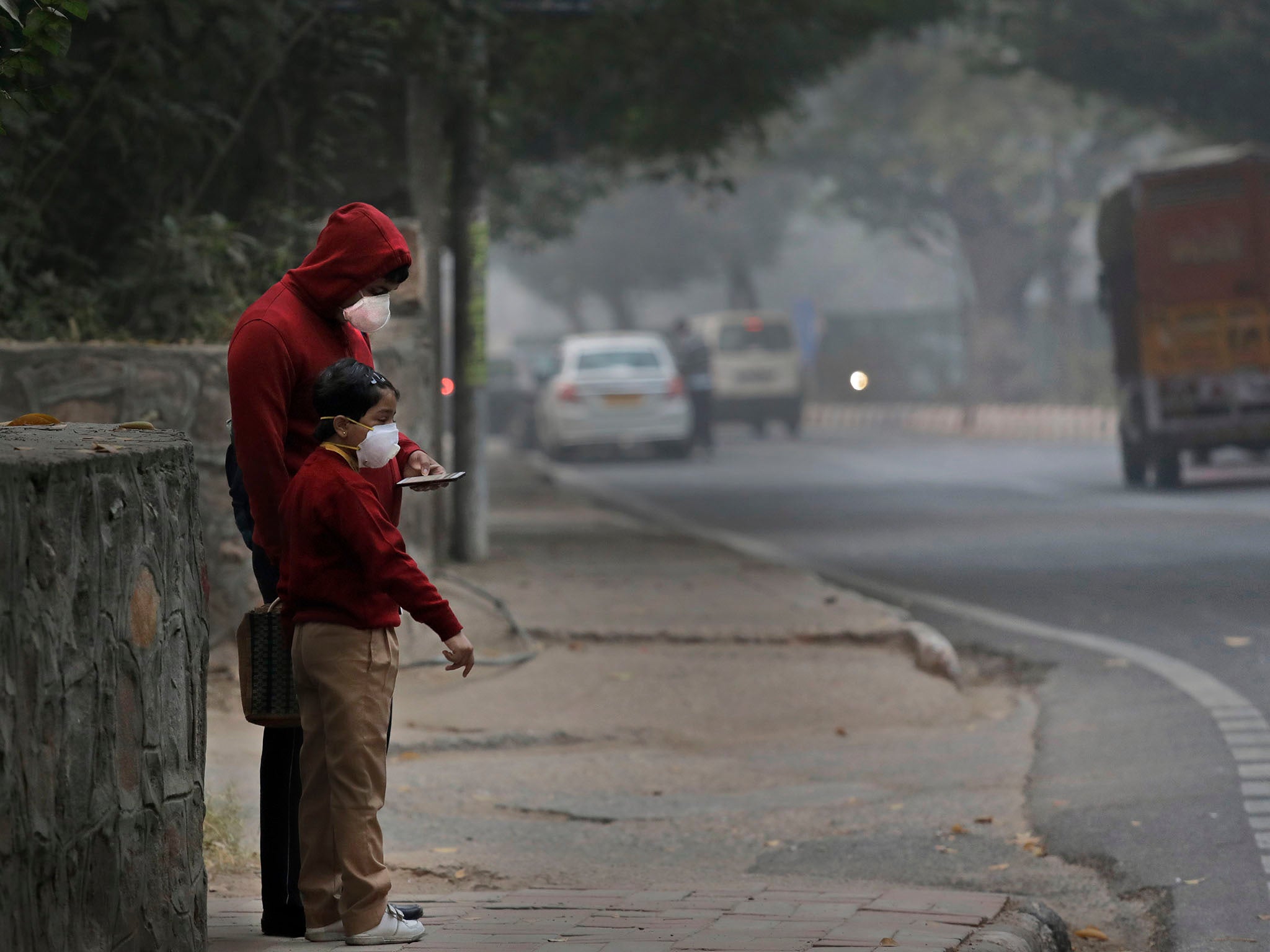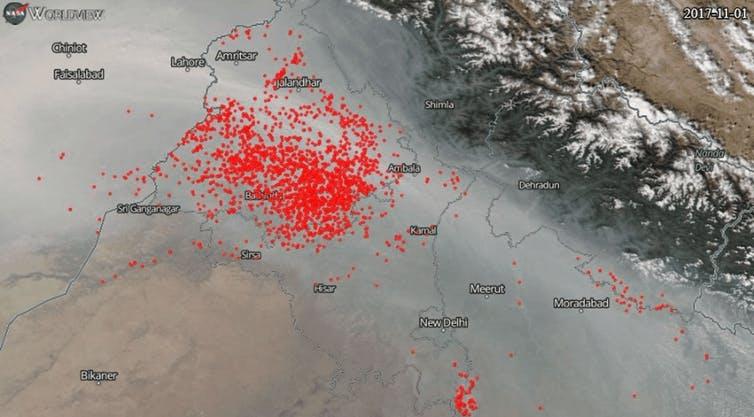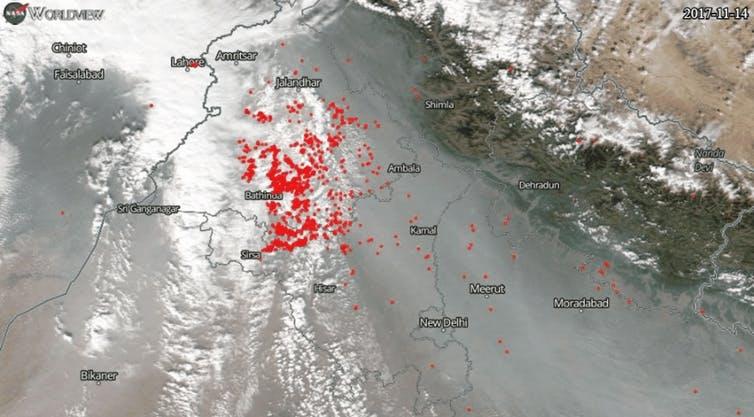Delhi suffers second smog crisis in 12 months, as wake-up calls go unheeded
Prolonged exposure to this level of pollution is equivalent to smoking more than two packs of cigarettes a day, experts say

Your support helps us to tell the story
As your White House correspondent, I ask the tough questions and seek the answers that matter.
Your support enables me to be in the room, pressing for transparency and accountability. Without your contributions, we wouldn't have the resources to challenge those in power.
Your donation makes it possible for us to keep doing this important work, keeping you informed every step of the way to the November election

Andrew Feinberg
White House Correspondent
A year ago Delhi was choking, as smog in the Indian capital soared to 16 times the government’s safe limit for particulate pollution. Now the same thing has happened again.
Levels of the most dangerous particles, called PM2.5, have once again reached last November’s levels: More than 700 micrograms per cubic metre in some parts of the city.
Experts say that prolonged exposure to this level of pollution is equivalent to smoking more than two packs of cigarettes a day. Just 12 months after the record-breaking pollution that should have been a major wake-up call, Delhi is again plunged into darkness. It is a big embarrassment that authorities were not better prepared for this year’s smog season.
In July, I released a detailed analysis of the factors that cause Delhi’s November smog. Based on data from India’s Central Pollution Control Board and from NASA, I concluded that Delhi’s record-breaking pollution in November 2016 was largely due to slow wind speeds and prevailing northerly winds, as well as Diwali fireworks, and the widespread practice of burning crop residues.
Others, including the Delhi government, reported similar findings. But this knowledge has not stopped it happening again, much to the frustration of Delhi residents who now face a second consecutive pollution-plagued winter.
Of course, the authorities do not control the wind speed or direction. But they can and should take steps to curb the other crucial factors.
Burning issue
In Haryana and Punjab states to the north of Delhi, farmers routinely burn their croplands after the summer harvest, ridding their fields of stubble, weed and pests and readying them for winter planting.
This agricultural event coincides with Diwali, India’s festival of lights, which features three or four nights of fireworks before and after the festival, in October or early November.
This series of NASA satellite images clearly shows the pollution plume moving across the landscape during the first two weeks of November. Red dots indicate live fires.


These images show that crop burning is still continuing, especially in parts of Punjab. As the graph below shows, crop burning produced significant amounts of pollution from 2 November 2017, after an earlier pollution spike around 20 October due to Diwali.
Other countries have taken measures to limit crop burning. In Australia, the Victorian state government strongly encourages farmers to retain crop stubble residues, although it allows sporadic burning. In some Canadian provinces, stubble burning is allowed by permit only.
There is no such legislation under consideration in India. But without a ban on crop burning, Delhi’s pollution woes are likely to continue. It is high time that the government responded, before Delhi’s pollution gets even more out of hand. Particles in the PM2.5 size range can travel deep into the respiratory tract, reaching the lungs.
Exposure to fine particles can cause short-term health effects such as eye, nose, throat and lung irritation, coughing, sneezing, runny nose and shortness of breath. Exposure to fine particles can also affect lung function and worsen medical conditions such as asthma and heart disease.
Studies have linked increases in daily PM2.5 exposure with increased respiratory and cardiovascular hospital admissions, emergency department visits and deaths. More than a million deaths in 2015 were attributed to India’s air pollution.
What governments and residents can do
There is a range of short- and long-term options to combat the problem. Farmers in Haryana and Punjab should be banned from residue crop burning during October and November, and should be given financial compensation for the inconvenience.
Meanwhile, Delhi’s residents should consider driving less, either by carpooling or using public transport. The city’s authorities, meanwhile, could restrict the entry of polluting trucks and heavy-duty goods vehicles, gradually phase out and ultimately ban older vehicles, and increase parking charges or restrict families to a single car.
A reliable 24-hour power supply would help to reduce the reliance on heavily polluting diesel generators in offices and factories. Subsidies for cleaner fuels or electric or hybrid cars would also help.
Authorities also have a duty to keep the public informed of pollution levels, through daily television, radio and social media updates, as well as pamphlets warning of the effects of air quality on health.
On the worst days, schools should be closed and children and older people urged to stay indoors. In the longer term, a “green belt” could be planted around the city, to help soak up traffic-induced air and noise pollution.
Many of these policies would involve significant upheaval. But Delhi needs action before it is too late. The alternative is to be plunged ever deeper into the murk.
Vijay Koul is an honorary fellow in bushfire dynamics and fire behaviour at CSIRO, Australia. This article was first published in The Conversation (theconversation.com)
Subscribe to Independent Premium to bookmark this article
Want to bookmark your favourite articles and stories to read or reference later? Start your Independent Premium subscription today.
Join our commenting forum
Join thought-provoking conversations, follow other Independent readers and see their replies
Comments